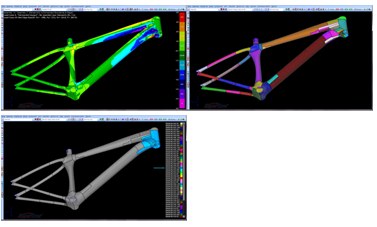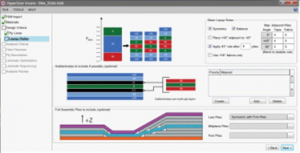Posted 3/8/2016
Source: TenLinks
![]() Manufacturers in an ever-widening array of industries are discovering the versatility of composites for strong, lightweight designs. Whatever the application, for the most cost-efficient and highest performance use of these advanced materials, design optimization software is essential.
Manufacturers in an ever-widening array of industries are discovering the versatility of composites for strong, lightweight designs. Whatever the application, for the most cost-efficient and highest performance use of these advanced materials, design optimization software is essential.
HyperSizer Express helps composite engineers in many different industries optimize their designs. This user-friendly tool employs key capabilities based on decades of advanced aerospace software development by Collier Research Corp.
Now, NASA-born Collier Research, a leader in the field of aerospace composites and metals optimization for more than 20 years, has just released HyperSizer Express, which delivers key capabilities of Collier’s high-end HyperSizer tool in a user-friendly package aimed at the composite engineer.
“Not every designer or engineer working with composites needs all the options in the professional version of our software,” says Collier founder and president Craig Collier. “But they do want the robustness of a proven, core analytical code running underneath, from the very early stages of their design process. HyperSizer Express provides all that – and it’s insanely fast and easy to use as well!”
Collier notes that 95 percent of users can, without a manual or instruction, import their finite element model (FEM) into Express and produce optimum composite laminates that satisfy all analyses to all load cases within 30 minutes. The automatically updated model will arrive at the minimum weight with global plies identified, layer by layer, producing fully manufacturable laminate designs.
“This kind of nonparametric optimization in Express is one reason it is so easy to use,” says Collier. “You don’t have to put in constraints or minimum/maximum values. You just say, ‘I want to make this out of carbon fiber,’ or ‘I want to make this out of fiberglass,’ and the software will show you the optimum solution based on your FEM.”
Tighter coupling to FEA optimizes product behavior analysis
Express is even more tightly coupled to FEA programs, such as NASTRAN and Abaqus, than the Pro version is. “Tight FEA coupling is key for the types of mechanical response analyses an engineer would carry out with Express,” says Collier. “These are driven primarily by bending stiffness, which requires a direct interaction with FEA solutions when optimizing laminate stackings.”
In the case of bike-frame design, for example, there are many “rideability” load cases, such as pedal startups and hard landings. “A common performance test carried out in the lab is to apply a force to the frame to simulate a front tire wall impact,” says Collier. “In addition to optimizing to strength criteria to prevent failure, manufacturers want to optimize their composite frames so they only displace a limited amount. These prescribed deflection limits represent desired handling of the bike. Express will effectively optimize the frame for these kinds of deflection limits, with fabric and unidirectional layers, to determine that best shape and location of the individual plies as well as the best orientation they should be placed in.
“These capabilities meet the needs of a broad range of composite engineers who work with laminates as well as with honeycomb or foam cored sandwiches,” he says.
Applications can include:
- Automotive – Doors, trunks, hoods, body panels, floor panels, body in white
- Sporting Goods – Bike frames, snowboards, tennis racquets
- Medical – Orthopedic prostheses
- Industrial – Robotic end effectors
- Marine – Yachts, sailboats
- Wind Energy – Turbine blades
- Aerospace – Seats, doors, winglets, flaps
A deep aerospace pedigree
Collier Research’s professional version of its software was the first to be commercialized out of NASA, and has most recently been used to help design the heat shield of the space program’s multipurpose crew vehicle, and the Bell Helicopter/Spirit AeroSystems entry in a Department of Defense program competition.
“When using Express you get the same exact margins of safety and the same exact material allowables as our Pro version intended for the aerospace industry, with 25 years of maturity and verification behind it,” says Collier. “But now it’s wrapped in a new interface streamlined for more efficient composite design optimization.”
Express and Pro products are both being used at large OEMs. Some parts are completely designed, analyzed, and certified with Express and others parts may first be done in Express, then handed off to Pro to do stiffened panels or bolted/bonded joints. The transition from Express to Pro is seamless because the two programs share the same database.
“Should you want to go to the Pro level later, all the data you’ve entered and computed with Express will be intact so you can see everything you’ve done so far,” says Collier.
Screenshots of a HyperSizer Express bike-frame analysis: (left) Import FEA stresses, (center) optimize property zones, (right) sequence laminates
How Express works
The Express interface guides the user through the entire analysis process in a highly intuitive manner, step-by-step. Checkboxes on the status console confirm current progress – from model import through material selection, FEA solver choice, selection of failure and design criteria, laminate optimization and sequencing, and analysis results (controlling load case, failure mode, safety factors, and update of FEM with optimal laminates). For complete details see the Express brochure.
Screenshot of HyperSizer Express composites ply layup tracking. Note interface checkmark system at upper left.
While Express is primarily aimed at the composite engineer, it does provide capabilities for metals optimization as well. “You can use Express to determine whether composite is really the material system you want to use for your product,” says Collier. “You can quickly identify the performance with a different metal, such as aluminum or steel.”
“Optimization has become an essential tenet of engineering,” Collier says. “But there are still so many people out there who are not doing any optimization at all,” he says. “Our aim is to support them with a user-friendly, practical tool that works for every engineer.”
About Collier Research Corp.
What began at NASA more than 20 years ago has continuously developed into today’s HyperSizer suite of structural software solutions. As Collier Research Corporation’s flagship product, HyperSizer performs design, stress analysis, and detailed sizing optimization for aircraft and space launch vehicles fabricated with composite or traditional metallic materials. On average, the software reduces the weight of structures by 20-40%, an exceptional achievement for aerostructures. HyperSizer replaces the need for spreadsheets and “hand calculations” with automatically generated stress reports for FAA certification. HyperSizer customers are able to produce results faster and more accurately, giving them an edge over competitors.
Collier Research Corp. provides software solutions, methods research, and consulting services for the aerospace, wind energy, and automotive industries with its broad range of structural capabilities. For more information on Collier Research Corp, visit HyperSizer.com.


